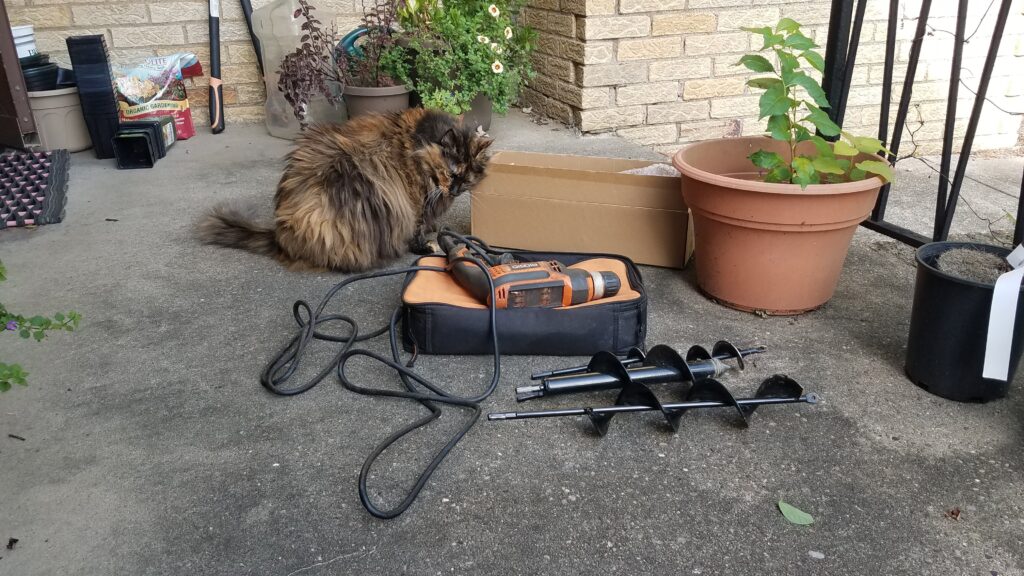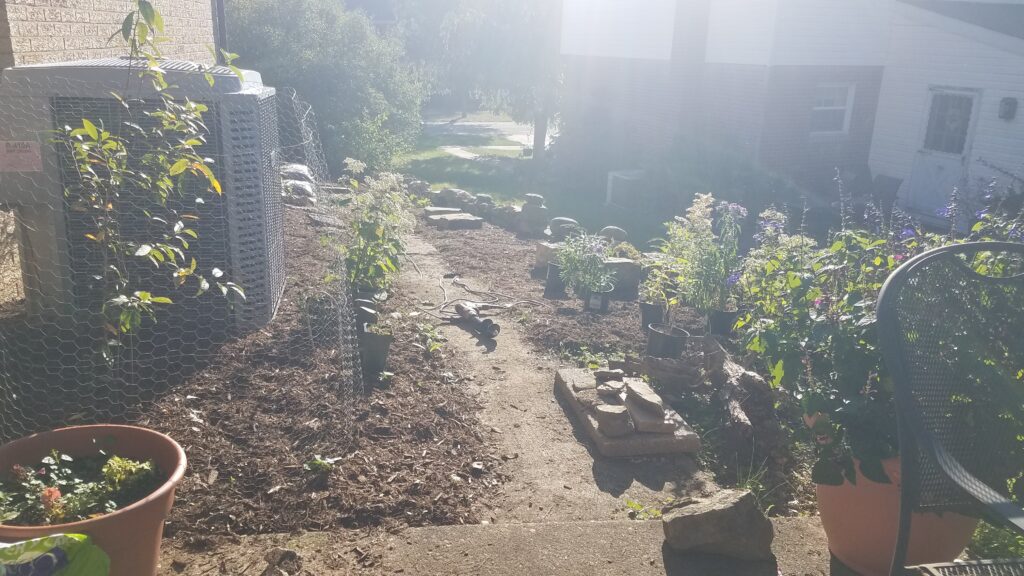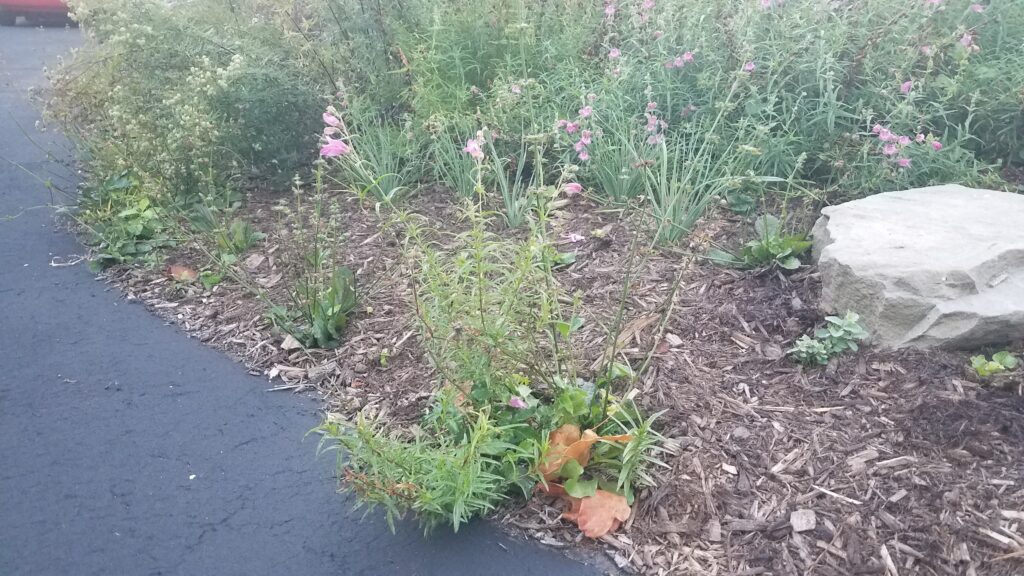The main things that limit my plant purchases when I go shopping at my local native plant nursery [1] are 1) car space, and 2) what I think I can plant in a given span of time. Note: I will also give myself rules, such as “you have to plant everything you bought before you go back again.” It has taken me a long time to get plants in the ground over the past few years because most of my garden space is in the process of being converted from lawn. That means there’s a thin layer of sod, and everything underneath is compacted clay and rock.
It is neither fun nor easy to plant in these new areas because it means digging large holes, breaking up the clay, mixing it with compost, and then filling the hole back in. I was told at a beekeeping conference back in 2017, in a session on creating a pollinator garden (back when this whole ordeal began), that if you continue to add mulch and/or compost to your new garden every year, it will start to condition the soil, and it will improve over time. Fortunately, I can attest to that, and some of the areas that have been garden for 4-5 years now are like cutting through butter.

Garden Augers
Nevertheless, it still takes time to dig, even when the soil doesn’t put up much of a fight. And since I once again bit off more than I could chew from a plant purchase standpoint, I wasn’t sure how much I would be able to get in the ground before we left for a two week vacation. Once it became apparent how little gardening time was available, I was concerned that my mother-in-law would be stuck watering far more unplanted flowers in pots than she had bargained for every day it didn’t rain. However, while she’s still got her work cut out for her, I saved us both some time with a tool I had been curious to try out for several years now.
I first heard about using an auger to drill holes for plants many years ago at that same beekeeping conference, in that same pollinator garden session. One of the speakers was talking about how quickly and easily he planted bulbs in the fall: drill a hole, drop in a bulb, drill a hole, drop in a bulb. I think it struck me as an excessive and unnecessary purchase at the time – after all, how hard is it to dig a hole? It hadn’t really crossed my mind again until this summer when a friend who is also an avid gardener mentioned how much she loved hers (even though she burned out her husband’s drill using it). With a large number of daffodil and narcissus bulbs left over from this spring waiting to go into the ground this fall, I decided it was time to revisit my options.
The set I bought included four different sizes, ranging from 1.6” to 3”. They fit into a standard hex drill, and ours (thankfully) is corded, since I’m sure I would have killed the battery multiple times while I was working. My first mistake was trying to use them in the yard in an area I was planning to convert to garden but hadn’t even started yet. For the record, don’t do that. I had to work my way up from the smallest to the largest size, as though I was drilling through rock, which is exactly what it felt like. I also was wearing shorts and sandals, and I was not wearing gloves or safety glasses. With the amount of rock chips in the soil, I am honestly surprised I didn’t hurt myself.

The Right Tool for the Job
Earlier in the summer (before my most recent shopping spree), I did get six lyre-leaved sage plants in the ground during that ill-advised maiden voyage of the auger set, but I don’t know that they’ll fare well in their tiny little clay cells, which are about the same size as their pots. I’m not sure that they’ll survive, but I also don’t want to try pulling them back out now that the weather is cold. That was my first attempt, and I realized that I was not using the right tool for the job. I know better: if I want to plant in a newer garden, it is going to be a long, tedious process of getting compost mixed into the soil so the plant has a fighting chance. But that was just my first try.
A few weeks later, after buying a carload of plants and having a moment of clarity once I got home and realized how little time I actually had to get them in the ground, I considered where I might like to plant them where I would also have better luck using the augers. In the end, I chose wisely: I stuck to places that had been garden for a few years (or had once been garden long before I moved in, such as the stretch along the back of the house that was previously home to a forest of Canada thistle.[2] Only a few spots were rockier because they were near our new concrete path [3] or a retaining wall,[4] but the rocks behind the retaining walls were far more obliging than I expected them to be. I still wasn’t wearing eye protection – don’t be like me.
In the places I drilled this time, there were only a few instances that didn’t meet with success – specifically, a couple places that were still very heavy clay and at least one place where I was clearly trying to drill into a large rock that was buried just a few inches down. Despite those six plants that still need to go in the ground, the speed at which I moved through my work was amazing. Using the auger, I put 35 plants in the ground in probably about three hours. That scale of work has taken me a full, uninterrupted weekend in the past.

If you’ve got a large gardening project and are dealing with moderately conditioned soil, there is no reason not to do yourself a favor and get some garden augers. (I’ll be continuing with them to plant an obscene number of bulbs after we get back from vacation.) Fortunately working smarter not harder helped me quickly get all of the following recent purchases in the ground:
- Aster – Aster ericoides ‘Snow Flurry’ – cultivar: groundcover version of the straight species (planted one set of 3) [5]
- Canada anemone – Anemone canadensis (planted one set of 6) [6]
- Coral bells – Heuchera americana (planted 2 sets of 3) [7]
- False boneset – Brickellia eupatorioides (one set of 3) [8]
- Hoary skullcap – Scutellaria incana (one set of 3) [9]
- Lanceleaf Coreopsis – Coreopsis lanceolata (3 in the ground, 3 to go) [10]
- New England aster – Symphyotrichum novae-angliae (3 interspersed with goldenrod, below) [11]
- Obedient plant – Physostegia verginiana ‘Pink Manners’ – cultivar: more slower-spreading and less prone to flopping than the species (4 of 6 in the ground) [12], [13]
- Sweet goldenrod – Solidago odora (2 of 3 in the ground, interspersed with NE Asters) [14]
You’ll see two new nativars on that list. I’ve already got several cultivars in the garden that seem to be frequented by many pollinators, most notably my Heliopsis helianthoides var. scabra ‘Burning Hearts’ (which is not native to Pennsylvania) [15] and Penstemon mexicali ‘Red Rocks’ (which is a hybrid of unknown origin). [16]
As I learned in research for last week’s post on native cultivars, [17] hybrids tend to be sterile (meaning they don’t produce seeds), and those that do produce seeds rarely have offspring that have the characteristics of the hybrid parent. Despite that, I’ve got Red Rocks volunteers coming up in my yard – and they look much like the parent plant (the same is true for the Heliopsis.) To me, it sounds like these plants at least are not representative of some of the worst aspects of cultivars and may still be providing value to my garden.
~
I’m still not quite done with my planting, but I’m glad that what’s left to do should be relatively easier now that I’ve got the right tools for the job.
Thanks for reading!
[1] https://arcadianatives.com/
[2] https://radicalmoderate.online/thinning-a-thicket-of-thistle/
[3] https://radicalmoderate.online/concrete/
[4] https://radicalmoderate.online/shaka-when-the-walls-fell-part-1/
[5] http://www.newmoonnursery.com/plant/Aster-ericoides-Snow-Flurry
[6] https://www.wildflower.org/plants/result.php?id_plant=ANCA8
[7] https://www.wildflower.org/plants/result.php?id_plant=HEAM6
[8] https://www.wildflower.org/plants/result.php?id_plant=BREU
[9] https://www.wildflower.org/plants/result.php?id_plant=SCIN
[10] https://www.wildflower.org/plants/result.php?id_plant=cola5
[11] https://www.wildflower.org/plants/result.php?id_plant=SYNO2
[12] https://www.rareroots.com/products/physostegia-virginiana-pink-manners
[13] https://www.wildflower.org/plants/result.php?id_plant=PHVI8
[14] https://www.wildflower.org/plants/result.php?id_plant=SOOD
[15] https://www.wildflower.org/plants/result.php?id_plant=HEHES
[17] https://radicalmoderate.online/planting-a-pollinator-garden-part-1
0 Comments